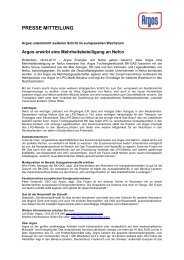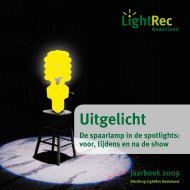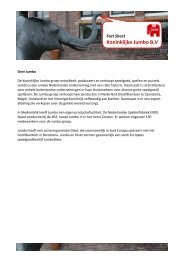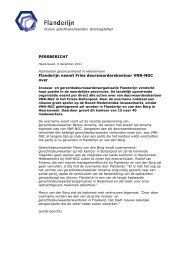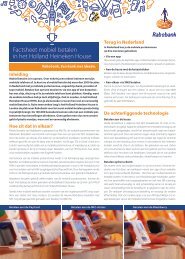PDF - Puremotion Technology White Paper - Nokia
PDF - Puremotion Technology White Paper - Nokia
PDF - Puremotion Technology White Paper - Nokia
You also want an ePaper? Increase the reach of your titles
YUMPU automatically turns print PDFs into web optimized ePapers that Google loves.
PureMotion <strong>Technology</strong>
PureMotion <strong>Technology</strong><br />
PureMotion <strong>Technology</strong> <strong>White</strong> <strong>Paper</strong><br />
PureMotion is the latest innovation of <strong>Nokia</strong> to radically improve the display<br />
capabilities. A set of new technologies ensures that the PureMotion HD+ display of the<br />
Lumia 920 smartphones is the fastest and brightest display and has the most sensitive<br />
touch on top of the high resolution.<br />
Fastest display<br />
All display technologies currently used in modern smartphones, i.e. liquid crystal<br />
displays (LCDs) and organic light-emitting diode (OLED) displays, suffer from<br />
inadequate smartphone video quality. While hardware (HW) and operating systems<br />
(OS) are capable of delivering smooth rendering at a steady rate of 60 frames per<br />
second (FPS) for most of the displayed content, display technologies are still designed<br />
for the era of lower rendering rates when fast-response time displays were not<br />
necessary. For consumers this means blurred display while scrolling, navigating,<br />
playing games, using the viewfinder etc.<br />
<strong>Nokia</strong>’s PureMotion technology is addressing the inadequate moving image quality in<br />
mobile displays, thus leveraging on the high-speed rendering capabilities of the<br />
graphics engine.<br />
Fast liquid crystal response and panel overdrive<br />
With the typical in-plane switching (IPS)-type liquid crystal display in mobile devices,<br />
the pixel transition time is longer than the period of one rendered frame i.e. 16.7<br />
milliseconds (ms). In practice the time it takes a pixel to change its state from one<br />
level to another is spanning over several frames, thus creating blur.<br />
© <strong>Nokia</strong> 2
In most LCDs white-to-black and black-to-white transitions are faster than transitions<br />
involving grey-to-grey level changes. Especially this is the case for twisted nematic<br />
(TN) and vertically aligned (VA) liquid crystals (LCs). IPS-type of LCDs, on the other<br />
hand, show a much smaller visible variation in transition times across grey levels. With<br />
grey-to-grey transitions, the crystal driving voltage difference between original and<br />
target state is smaller leading to slower turning of the liquid crystal molecules, which<br />
get even slower at lower temperatures<br />
The way to overcome this problem is to use a temporary higher voltage difference for<br />
driving each LC pixel i.e. to overdrive the panel. This leads to the PureMotionHD<br />
having the best video quality.<br />
Figure 1. Illustration of the overdrive principle<br />
3
PureMotion <strong>Technology</strong><br />
In the end overdrive contributes to both reducing the liquid crystal rise time and also<br />
improving the consistency of the transitions as can be seen in the following<br />
measurement data. In the charts height of the bar indicates transition time.<br />
Figure 2. Transition times for normal (left) and overdriven (right) IPS-like LCDs.<br />
In order to be able to show any image at good motion quality with 60fps, liquid<br />
crystals need to complete their transition from the previous frame before transition<br />
starts for the next frame. In practice this means that LC transition time needs to be<br />
below one frame time for any transition, because it also takes some time to write the<br />
image to the display (panel addressing time).<br />
Figure 3. PureMotion HD+ display panel update in the top image and panel data after update in the bottom<br />
image<br />
© <strong>Nokia</strong> 4
With overdrive-enhanced LC response, PureMotion display pixels finish their transition<br />
well before the update of the next frame for any pixel needs to start, resulting in a<br />
less blurry image.<br />
Visible shadow image<br />
from the previous<br />
frame<br />
Figure 4. Conventional IPS-like display update where slow pixel response time leads to shadow images<br />
In a normal IPS-like LCD having longer ~23ms LC response time, previous frame has<br />
not yet been fully updated when the pixels already needs to be updated again. In<br />
practice this means that during image motion, some of the pixels never reach the<br />
intended value, resulting in a more blurry image and even miscoloured edges (color<br />
bleeding).<br />
5
PureMotion <strong>Technology</strong><br />
Brightest<br />
Smartphones rely completely on touch screen operation. In bright sunlight most<br />
displays turn non-readable and non-usable. It is close to impossible to read text<br />
messages or browse, even making a call<br />
becomes very difficult. For consumers this is a<br />
major usability problem. With PureMotion<br />
technology, we are introducing innovation<br />
solving these problems.<br />
Building on top of innovations in the ClearBlack technology, PureMotion introduces<br />
new innovation on outdoor viewing experience in mobile displays. In addition to the<br />
very low reflectance, which largely improves dark tone rendering in ambient light,<br />
PureMotion adds high luminance mode for backlight LED-driving and image contrast<br />
enhancement, on top of superb optical stack design. Together they improve the<br />
overall contrast and thus brightness and sunlight readability.<br />
In an extremely bright environment the Lumia 920 PureMotion display its backlight<br />
luminance reserve and becomes the smartphone WXGA (1280x768) display with<br />
highest peak luminance. For user high luminance mode is fully automatic, working<br />
based on the data coming from ambient light sensor.<br />
The adaptive image contrast enhancement compensates the loss of contrast caused<br />
by the unavoidable ambient light reflections inside the display-touch-window optical<br />
stack. It enhances the display readability by altering the user interface graphics color<br />
and contrast mathematically and optimizes it dynamically for any ambient light<br />
viewing condition. These sunlight readability enhancements are fully automatic for the<br />
user.<br />
© <strong>Nokia</strong> 6
Figure 5: Original photo<br />
Figure 6: Phones under direct sunlight: Lumia 900 (which has been praised having very good outdoor<br />
visibility) on the left and Lumia 920 on the right demonstrating the effect sunlight readability enhancement<br />
improving greatly the visibility of dark shades in high illuminance.<br />
7
PureMotion <strong>Technology</strong><br />
Highest pixel count: HD+<br />
To achieve the best smartphone video on the market, the first PureMotion display has<br />
a pixel count of 1280x768, also called WXGA. HD+ refers to the fact that WXGA has<br />
7% more pixels than regular 720p (1280x720) and 15:9 aspect ratio. Also it has 60%<br />
more pixels than DVGA (960x640) and response fast enough to show content<br />
rendered at 60fps in a blur free fashion.<br />
HD+ provides the best balance for content viewing and UI usability of touch screen.<br />
When browsing, looking at photos, watching videos etc. you get more content in one<br />
go. 15:9 aspect ratio gives better usability compared to 16:9. User interface elements,<br />
which are at top edge of the screen, are closer to the users fingers, thus being more<br />
reachable also with thumbs.<br />
Figure 7: Comparison between the amount of content visible in WXGA HD+ display vs. DVGA and 720p<br />
© <strong>Nokia</strong> 8
Most sensitive touch<br />
People with long fingernails haven’t been able to use touch screen by the most natural<br />
way - with nails. They have needed to learn a new way to touch the screen by<br />
bending their fingers into all kinds of positions. This makes the use of a smartphone<br />
more cumbersome and not that easy as it could be. There are also moments when<br />
you want to use gloves. For example in cold weather you would rather keep the<br />
gloves on than pulling them off to make a call. As funny as it may appear, many<br />
people have even learned to answer their phone by their nose, not taking their gloves<br />
off.<br />
Super sensitive touch in Lumia 920 sets a new bar in touch display experience since<br />
the introduction of capacitive touch in smartphone mass market 2007. So far it’s been<br />
about multitouch and usage of the device with bare fingers or stylus but now there will<br />
finally be a radical user experience improvement. <strong>Nokia</strong> is the first smartphone<br />
manufacturer to bring super sensitive and best touchscreens to the market. The touch<br />
in Lumia 920 is more sensitive than in any other touch display enabling interaction not<br />
only with your bare fingers but also with gloves, long finger nails and even some<br />
regular pens. This technology adapts its sensitivity according to user input method,<br />
making touch usage faster, more natural and accurate.<br />
Figure 8: Comparison between conventional and super sensitive touch<br />
9
PureMotion <strong>Technology</strong><br />
Lumia Lumia 920 display specification<br />
Diagonal size: 4.5”<br />
Resolution: 332 pixels per inch (PPI)<br />
Pixel count: 1280x768 (WXGA HD+)<br />
Luminance control levels: 8bit i.e. 256 levels<br />
Grey-to-grey pixel transition time: average
Additional Resources:<br />
<strong>Nokia</strong> Beta Labs<br />
- <strong>Nokia</strong> Beta Labs brings together developers and consumers keen on improving<br />
products and accelerating innovation.<br />
<strong>Nokia</strong> Conversations<br />
- Conversations by <strong>Nokia</strong> is a site that tells compelling stories about the global<br />
cultures, technology and people shaping mobile, and smartphone innovation.<br />
<strong>Nokia</strong> Lumia Smartphones<br />
- See the range of award winning smartphones that have the latest smartphone<br />
technology such as the <strong>Nokia</strong> Lumia 920<br />
11









